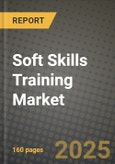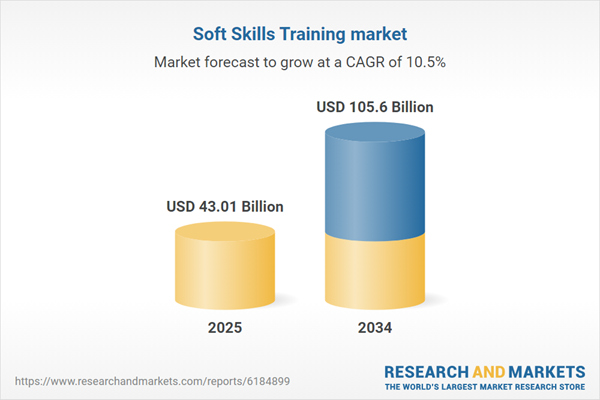Soft Skills Training market
The Soft Skills Training market centers on building human capabilities - communication, leadership, collaboration, critical thinking, empathy, and adaptability - that drive performance across roles and industries. Demand is strongest in corporate L&D, frontline sales and service, emerging leaders, healthcare and education workforces, and tech teams navigating cross-functional delivery. Programs are shifting from one-off workshops to blended, continuous learning journeys that combine live facilitation with digital microlearning, peer practice, and on-the-job reinforcement. Key trends include AI-enabled coaching and nudges, cohort-based learning, skills taxonomies linked to roles, manager-as-coach models, and credentialing via badges to signal verified proficiency. Buyers prioritize measurable behavior change, scalable delivery for hybrid work, multilingual localization, and content tailored to industry contexts (e.g., patient communication, safety leadership, consultative selling). Competitive dynamics span global training firms, specialist boutiques, enterprise L&D platforms, and HR tech providers embedding soft-skills modules into LXPs/LMSs. Differentiation hinges on evidence-based curriculum, facilitator networks, experiential practice (role plays, simulations, VR), analytics that track application back to business KPIs, and implementation support that embeds learning into workflows (e.g., CRM and collaboration tools). Vendor partnerships with HRIS/LMS providers, universities, and industry bodies broaden distribution. As organizations navigate ongoing transformation - AI adoption, customer experience mandates, compliance culture, and change fatigue - soft skills are viewed as critical risk mitigation and value creation levers. The market is maturing toward outcome-based contracting, with increased emphasis on application, retention, and transfer, not just attendance and satisfaction.Soft Skills Training market Key Insights
- From events to ecosystems. Buyers are moving beyond classroom “events” toward multi-month journeys that mix live practice, microlearning, reflection prompts, and manager touchpoints. Programs that scaffold pre-work, spaced repetition, and social accountability show higher transfer. Platforms that automate reminders and workflow-embedded practice reduce drop-off and sustain behavior change.
- AI as force multiplier. Generative AI augments coaching, role-play, and feedback through scenario simulators, personalized prompts, and language analysis. Providers win by pairing AI with human facilitation, clear data governance, and ethics guardrails. The sweet spot: AI for scale and personalization; humans for nuance, psychological safety, and cultural calibration.
- Skills architectures matter. Organizations want skills taxonomies mapping competencies to roles and levels, with rubrics and observable behaviors. Vendors that align content to role profiles, career paths, and internal mobility frameworks gain stickiness. Assessments at baseline and post-program enable targeted pathways and clearer ROI storytelling to leadership.
- Manager-as-coach is pivotal. The strongest predictor of transfer is manager involvement - coaching guides, 1:1 templates, and sprint retros tied to performance routines. Toolkits that fit into weekly cadences (stand-ups, pipeline reviews, patient huddles) convert learning into habits. Incentives for managers (OKRs, recognition) further raise adoption.
- Experiential > didactic. Adults build soft skills through deliberate practice: live role-plays, peer feedback, simulations, and customer-scenario labs. VR/AR and AI agents increase realism and repetition without travel. Debriefs using behavior-based rubrics accelerate insight and confidence, especially for conflict, negotiation, and feedback conversations.
- Localization and inclusion. Global employers require multilingual content, culturally aware examples, and accessibility by design. Programs that integrate inclusion, psychological safety, and bias-aware communication outperform generic offerings. Industry-specific storytelling (clinics, plants, contact centers) drives relevance and learner pull.
- Measurement moves upstream. Stakeholders expect clear logic chains from skills to outcomes: leading indicators (practice completion, quality of role-plays), behavioral evidence (manager ratings, peer feedback), and business proxies (NPS, conversion, safety incidents). Providers differentiate with dashboards, control-group designs, and integration with HR and CRM data.
- Packaged for functions. High-velocity adoption in sales (discovery, negotiation, account influence), customer service (de-escalation, empathy), operations (safety leadership, shift handovers), and product/tech (stakeholder alignment). Function-specific playbooks and tool integrations (e.g., CRM prompts, ticketing notes) accelerate in-flow application.
- Change fatigue & time scarcity. Learners are overloaded; short, mobile-first bursts and “learn while doing” moments perform best. Cohort cadence, office hours, and community forums keep momentum. Champions networks and internal facilitator upskilling lower costs and increase cultural fit over time.
- Vendor landscape convergence. Lines blur between training firms, coaching networks, and learning platforms. Winning providers bundle content libraries, facilitation talent, practice tech, and analytics - often via partnerships. Procurement favors modularity, interoperability (LXP/LMS/HRIS), and outcome-linked pricing with flexible delivery (virtual, in-person, hybrid).
Soft Skills Training market Reginal Analysis
North America
Demand is propelled by large enterprises formalizing skills frameworks, sales enablement modernization, and workforce transformation tied to AI adoption. Buyers emphasize measurable outcomes, integration with HRIS/CRM stacks, and manager enablement. Remote/hybrid work cements virtual delivery with periodic in-person intensives. Highly regulated sectors (healthcare, financial services) seek tailored scenarios and credentialing. Competition is intense among global firms, boutiques, and tech-led platforms; partnerships and data-rich case studies sway procurement.Europe
Emphasis on inclusion, worker councils, and country-specific labor norms drives tailored curricula and localized facilitation. Public sector and regulated industries value evidence-based approaches and recognized credentials. Multilingual delivery and accessibility compliance are mandatory in RFPs. Hybrid learning with strong experiential components is preferred, with growing interest in coaching at scale and skills taxonomies aligned to career frameworks. Data privacy expectations shape AI features and analytics deployment, favoring transparent, configurable solutions.Asia-Pacific
Rapid digitization, large graduate cohorts, and service-led economies fuel demand across technology, BFSI, and healthcare. Employers seek scalable, mobile-first programs, often delivered virtually with regional facilitator hubs. Localization is critical - examples, language nuance, and cultural norms around feedback. Government upskilling initiatives and multinational expansions create volume. Buyers increasingly request manager-as-coach toolkits and function-specific labs (sales, customer success). Partnerships with universities and industry bodies help with recognition and reach.Middle East & Africa
Economic diversification, national transformation agendas, and service sector expansion elevate soft skills as a workforce priority. Enterprises prefer blended formats to reduce travel while preserving high-impact facilitation for leadership and customer-facing roles. Localization (Arabic, French, regional contexts) and culturally attuned change-management are differentiators. Energy, government, and hospitality lead adoption, with growing interest in coaching networks and foundational communication for early-career populations.South & Central America
Organizations prioritize customer experience, service quality, and frontline leadership as they digitize operations. Budget sensitivity favors modular programs, internal facilitator development, and outcome-based engagements. Spanish/Portuguese localization, virtual cohorts, and mobile delivery increase reach across dispersed teams. Sectors such as retail, banking, BPO, and healthcare show steady uptake. Vendors that combine practical toolkits, manager enablement, and integration with collaboration platforms see stronger retention.Soft Skills Training market Segmentation
By Type
- In-Person Workshops
- Online Courses and Webinars
- E-Learning Platforms
- Others
By Application
- Communication Skills
- Leadership and Management
- Teamwork and Collaboration
- Time Management
- Others
By End-User
- Information Technology
- Healthcare and Life Sciences
- Finance and Banking
- Manufacturing
- Retail
- Others
Key Market players
Dale Carnegie Training, FranklinCovey, Korn Ferry, Skillsoft, GP Strategies Corporation, Wilson Learning, BTS, Lee Hecht Harrison (LHH Sodexo), Training Folks, TrainSMART, The Institute for Health & Human Potential (IHHP), The Soft Skills Group (TSSG), Huthwaite International, ESI International, Video ArtsSoft Skills Training Market Analytics
The report employs rigorous tools, including Porter’s Five Forces, value chain mapping, and scenario-based modelling, to assess supply-demand dynamics. Cross-sector influences from parent, derived, and substitute markets are evaluated to identify risks and opportunities. Trade and pricing analytics provide an up-to-date view of international flows, including leading exporters, importers, and regional price trends.Macroeconomic indicators, policy frameworks such as carbon pricing and energy security strategies, and evolving consumer behaviour are considered in forecasting scenarios. Recent deal flows, partnerships, and technology innovations are incorporated to assess their impact on future market performance.
Soft Skills Training Market Competitive Intelligence
The competitive landscape is mapped through proprietary frameworks, profiling leading companies with details on business models, product portfolios, financial performance, and strategic initiatives. Key developments such as mergers & acquisitions, technology collaborations, investment inflows, and regional expansions are analyzed for their competitive impact. The report also identifies emerging players and innovative startups contributing to market disruption.Regional insights highlight the most promising investment destinations, regulatory landscapes, and evolving partnerships across energy and industrial corridors.
Countries Covered
- North America - Soft Skills Training market data and outlook to 2034
- United States
- Canada
- Mexico
- Europe - Soft Skills Training market data and outlook to 2034
- Germany
- United Kingdom
- France
- Italy
- Spain
- BeNeLux
- Russia
- Sweden
- Asia-Pacific - Soft Skills Training market data and outlook to 2034
- China
- Japan
- India
- South Korea
- Australia
- Indonesia
- Malaysia
- Vietnam
- Middle East and Africa - Soft Skills Training market data and outlook to 2034
- Saudi Arabia
- South Africa
- Iran
- UAE
- Egypt
- South and Central America - Soft Skills Training market data and outlook to 2034
- Brazil
- Argentina
- Chile
- Peru
Research Methodology
This study combines primary inputs from industry experts across the Soft Skills Training value chain with secondary data from associations, government publications, trade databases, and company disclosures. Proprietary modeling techniques, including data triangulation, statistical correlation, and scenario planning, are applied to deliver reliable market sizing and forecasting.Key Questions Addressed
- What is the current and forecast market size of the Soft Skills Training industry at global, regional, and country levels?
- Which types, applications, and technologies present the highest growth potential?
- How are supply chains adapting to geopolitical and economic shocks?
- What role do policy frameworks, trade flows, and sustainability targets play in shaping demand?
- Who are the leading players, and how are their strategies evolving in the face of global uncertainty?
- Which regional “hotspots” and customer segments will outpace the market, and what go-to-market and partnership models best support entry and expansion?
- Where are the most investable opportunities - across technology roadmaps, sustainability-linked innovation, and M&A - and what is the best segment to invest over the next 3-5 years?
Your Key Takeaways from the Soft Skills Training Market Report
- Global Soft Skills Training market size and growth projections (CAGR), 2024-2034
- Impact of Russia-Ukraine, Israel-Palestine, and Hamas conflicts on Soft Skills Training trade, costs, and supply chains
- Soft Skills Training market size, share, and outlook across 5 regions and 27 countries, 2023-2034
- Soft Skills Training market size, CAGR, and market share of key products, applications, and end-user verticals, 2023-2034
- Short- and long-term Soft Skills Training market trends, drivers, restraints, and opportunities
- Porter’s Five Forces analysis, technological developments, and Soft Skills Training supply chain analysis
- Soft Skills Training trade analysis, Soft Skills Training market price analysis, and Soft Skills Training supply/demand dynamics
- Profiles of 5 leading companies - overview, key strategies, financials, and products
- Latest Soft Skills Training market news and developments
Additional Support
With the purchase of this report, you will receive:- An updated PDF report and an MS Excel data workbook containing all market tables and figures for easy analysis.
- 7-day post-sale analyst support for clarifications and in-scope supplementary data, ensuring the deliverable aligns precisely with your requirements.
- Complimentary report update to incorporate the latest available data and the impact of recent market developments.
This product will be delivered within 1-3 business days.
Table of Contents
Companies Mentioned
- Dale Carnegie Training
- FranklinCovey
- Korn Ferry
- Skillsoft
- GP Strategies Corporation
- Wilson Learning
- BTS
- Lee Hecht Harrison (LHH Sodexo)
- Training Folks
- TrainSMART
- The Institute for Health & Human Potential (IHHP)
- The Soft Skills Group (TSSG)
- Huthwaite International
- ESI International
- Video Arts
Table Information
| Report Attribute | Details |
|---|---|
| No. of Pages | 160 |
| Published | November 2025 |
| Forecast Period | 2025 - 2034 |
| Estimated Market Value ( USD | $ 43.01 Billion |
| Forecasted Market Value ( USD | $ 105.6 Billion |
| Compound Annual Growth Rate | 10.5% |
| Regions Covered | Global |
| No. of Companies Mentioned | 15 |









